
Christ is born! Glorify him!
1. Secular Christmas
Some of our Christmas customs are fairly modern by Orthodox reckoning (we’ve been around for a long time): Christmas cards and gifts *, special family traditions, candy and cookies ( I can still taste the anise Christmas cookies my German grandmother made). “I’m Dreaming of a White Christmas”, and all the rest. These lovely customs and many others help draw people together in love. They are all to the good, even if they have no direct connection to the Birth of Christ.
- I hope you, like a hobbit, love getting presents. That’s means you are humble enough to give others the joy of giving.
Other Christmas customs have pre-Christian, maybe even “druid” origins: holly and ivy and mistletoe and evergreen trees and lights. (Bringing trees indoors is an odd custom, if you think about it. I wonder what future historians and archaeologists will make of it.) All these were ancient symbols of continuing life and light during the cold, dark northern winter. We have transformed them into signs of everlasting life in Christ.
Taking pre-Christian things and Christianizing them is just fine. To begin with, mothers had babies Before Christ! but by her Birth-giving, Mary the Theotokos has made all birth-giving holy.
I can’t resist sharing these with you, both pictures courtesy of my wife. 
Our Christmas tree at Saint Nicholas
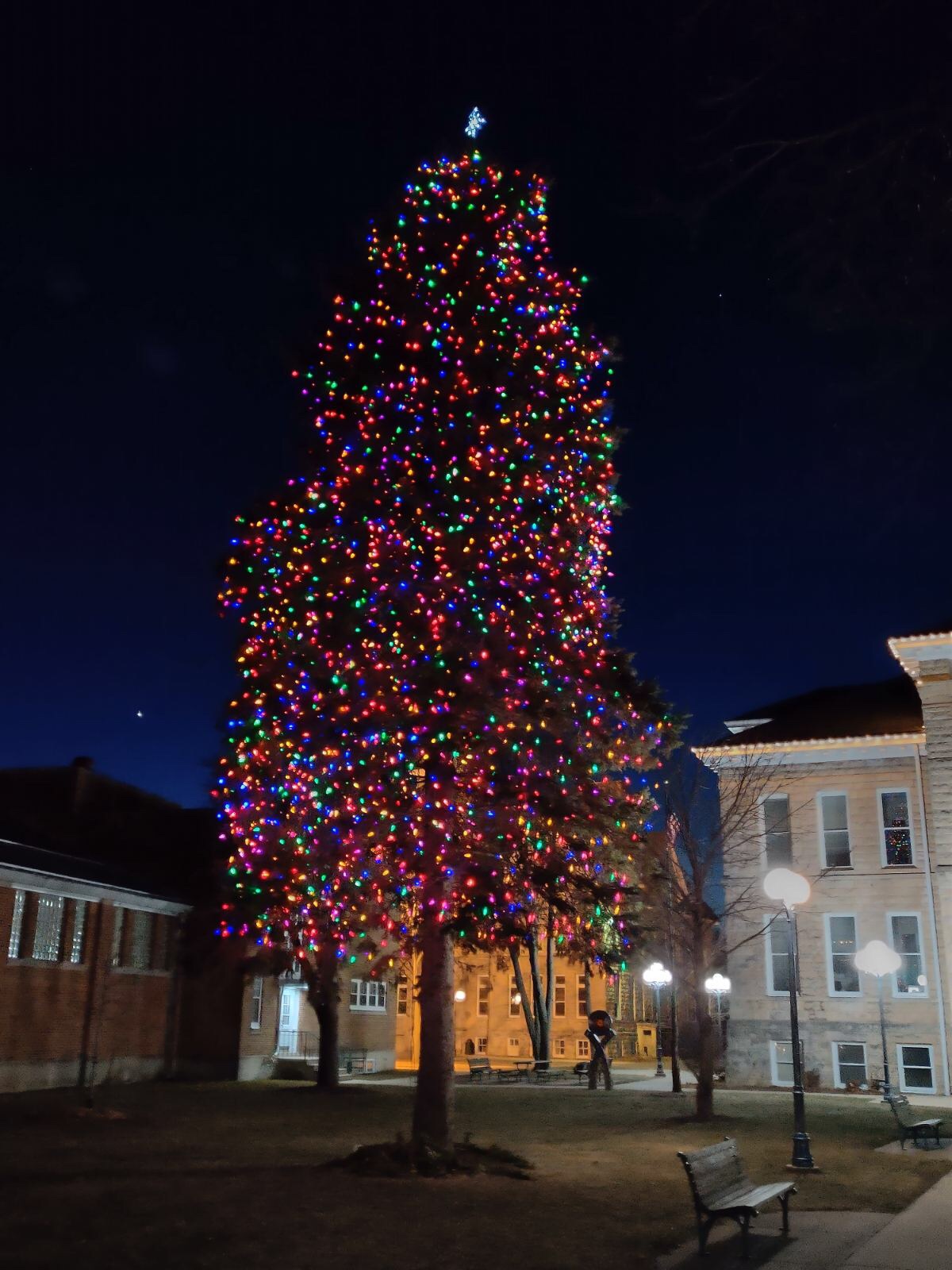
Our Cedarburg city Christmas Tree. Might that be the Star of Bethlehem in the sky to the left? No snow for Christmas in southern Wisconsin this year…
2. Santa Claus Christmas
Santa, that jolly old person or elf, or whatever he is or was. Mythology by its nature is forever changing. And, as I’ve told you before, over the centuries our dear Saint Nicholas has been mythologized into today’s Santa Claus. But even Saint Nicholas himself has no traditional connection with the Nativity of Christ. In parts of western Europe, for a long time he (in one guise or another) was said to bring a small gift for children on Saint Nicholas Day, December 6. That’s if you had been good; otherwise you got a lump of coal. In some places in Germany he carried a stick so he could beat you if you had been bad! My dad’s family had the December 6 tradition, and many families here in Milwaukee still continue it.
Not till the poem “A Visit from Saint Nicholas” in the early 19th century did he turn into a Norse elf who brought gifts on “the night before Christmas”. Say “Saint Nicholas” four times fast, and you will know how people who didn’t know anything about the Saint changed his name to “Santa Claus”. And, as I pointed out in an earlier Blogpost, here is how his garments were mythologized into Santa’s.
From Orthodox Saint Nicholas
![]()
to Western Saint Nicholas
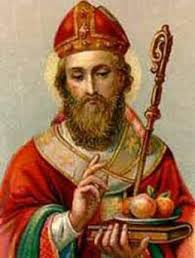
to today’s Santa Claus

and who knows what comes next, as mythology keeps changing.
When I was a little boy seventy-five year ago (I italicize that because it shocks me), Santa still was a wonderful, mysterious figure. Today I think he’s lost his charm, as he appears on every other TV commercial selling toothpaste or whatever. Even if we wanted to, there’s no way to escape from Santa in our culture today. And little children still believe, and it’s so much fun to see their excitement and wonder at Christmas. So I say Hooray for Santa Claus! Up to a point.
What we need to do is rescue him, re-Christianize him. At Christmas Divine Liturgy I gave this advice (in an intentionally abstruse way because little children were present) on how to handle it: “Parents, never prevaricate with your children. When our little Jennie and David began to wonder, Khouria Dianna and I just asked them What do you think? Then they were free to think what they thought till they thought something else, and then we told them the story of the real Saint Nicholas who give us gifts all the time.” It makes a simple beautiful transition, and thus Santa Claus is restored to his original self. It worked well for us.
Remember, again, that neither of these first two popular versions of Christmas has anything to do with the birth of Christ. I see signs in peoples’ yards: “Keep Christ in Christmas”. I didn’t know he had left! It’s just that he gets ignored amidst all the modern “Christmas” commotion. I wonder what in the world future historians might make of this: Were people of our era worshiping Jesus Christ? …surely they didn’t worship a Norse elf! But they certainly seemed to pay a whole lot more attention to the elf than they did to the Baby!
I didn’t know he had left! It’s just that he gets ignored amidst all the modern “Christmas” commotion. I wonder what in the world future historians might make of this: Were people of our era worshiping Jesus Christ? …surely they didn’t worship a Norse elf! But they certainly seemed to pay a whole lot more attention to the elf than they did to the Baby!
3. Winter Solstice Christmas
From time immemorial people in the northern hemisphere have celebrated the turn of the year, the return of the sun. Not, as we hear sometimes, because the ancients were ignorant and feared the sun might not come back. They knew the heavens a whole lot better than most of us do. But, oh! Now the days begin to grow longer. The light is returning. That is worth celebrating!
Here is how this pagan festival got connected with our celebration of Christ’s Nativity. I’m sure you know that the actual date of Jesus’ birth is not known. In the Fourth Century pagan Romans celebrated the winter solstice on December 25 with a festival called Sol Vinvictus 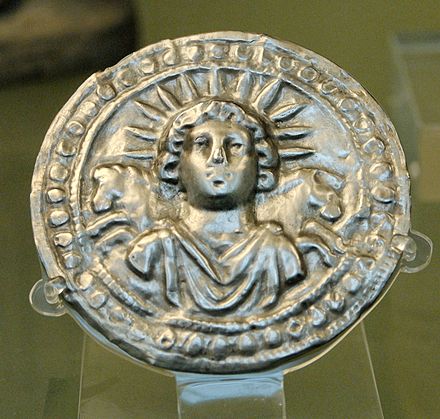 , the Unconquered Sun. to the left So Christians, led by the new Emperor Constantine, stole it! They placed the celebration of the Lord’s birth on December 25 – for Jesus Christ is the Unconquered Light, now born into the world, “the Light which knows no evening”, which “the darkness could not overcome”. This was such a perfect symbol * that it spread throughout the Christian world, even back into the East. So, dear Orthodox readers, we got our date of Christmas from pagan Rome and then from Christian Rome! * **
, the Unconquered Sun. to the left So Christians, led by the new Emperor Constantine, stole it! They placed the celebration of the Lord’s birth on December 25 – for Jesus Christ is the Unconquered Light, now born into the world, “the Light which knows no evening”, which “the darkness could not overcome”. This was such a perfect symbol * that it spread throughout the Christian world, even back into the East. So, dear Orthodox readers, we got our date of Christmas from pagan Rome and then from Christian Rome! * **
- In the southern hemisphere Christmas comes, of course, at the summer solstice, the height of the sun. Do we have any “southern-hemispheric” readers here? How do you handle this symbolically?
- For an entirely different “take” on this, please read the first comment below.
4. The Real Christmas
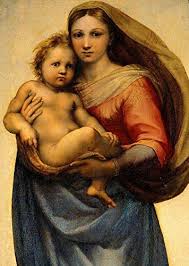 On Christmas cards and in a lot of classical Western Christmas art, we see a sweet scene of the Madonna holding her little baby Jesus. Why is he so often portrayed as a huge Baby? Of course, the Birth of her Son and Lord was wonderful to behold, and likewise the visits of the shepherds and Wise Men. But was it actually all that sweet? Mothers, how would you feel about riding sixty miles, pregnant, on the back of a donkey? about giving birth far from home in a drafty, chilly, smoky cave, “no crib for a bed”, and no bed for you either or for old Joseph who surely
On Christmas cards and in a lot of classical Western Christmas art, we see a sweet scene of the Madonna holding her little baby Jesus. Why is he so often portrayed as a huge Baby? Of course, the Birth of her Son and Lord was wonderful to behold, and likewise the visits of the shepherds and Wise Men. But was it actually all that sweet? Mothers, how would you feel about riding sixty miles, pregnant, on the back of a donkey? about giving birth far from home in a drafty, chilly, smoky cave, “no crib for a bed”, and no bed for you either or for old Joseph who surely  needed one? and then immediately having to flee for your lives as refugees into a land you’ve never seen before? and stay there for years as outsiders? This was tough – which I think may be one reason why, in most of our icons of the Holy Mother and Child, she doesn’t look “sweet” and comfortable. There’s also another much more significant reason. We’ll come to that.
needed one? and then immediately having to flee for your lives as refugees into a land you’ve never seen before? and stay there for years as outsiders? This was tough – which I think may be one reason why, in most of our icons of the Holy Mother and Child, she doesn’t look “sweet” and comfortable. There’s also another much more significant reason. We’ll come to that.
5. Some Implications of Christmas
Surely the birth of our Lord and Savior in a cave must give us sympathy for the homeless today. Every night in America half a million people live in the streets, with nowhere to lay their heads. In we’re paying any attention at all, the Nativity of our Lord will make us ask: What we can do to help the homeless and hungry? Like support our homeless shelters which are overcrowded and inadequate. And give to the food pantries and meal programs. And maybe take some time to work there.
 And the Flight of the Holy Family into Egypt makes me wonder: What if Herod had now discovered that his men had failed – the Young King had escaped – and his men were in pursuit. And if Joseph, with great fear and hope, had brought his Family to the edge of Egypt and there found a wall keeping them out? Or what if there had been border agents making it as difficult as possible to let refugees into Egypt, that wealthy land? Or what if they had got in and the Egyptians had separated the Baby Jesus from his Holy Mother and Joseph, their guardian? or maybe sent Him off to stay with strangers? or put Him in an orphanage? or worse maybe put the Child Jesus into a pen?
And the Flight of the Holy Family into Egypt makes me wonder: What if Herod had now discovered that his men had failed – the Young King had escaped – and his men were in pursuit. And if Joseph, with great fear and hope, had brought his Family to the edge of Egypt and there found a wall keeping them out? Or what if there had been border agents making it as difficult as possible to let refugees into Egypt, that wealthy land? Or what if they had got in and the Egyptians had separated the Baby Jesus from his Holy Mother and Joseph, their guardian? or maybe sent Him off to stay with strangers? or put Him in an orphanage? or worse maybe put the Child Jesus into a pen?
I’m sorry * but, amidst all the joy and fun of Christmas, I can’t help but think about these things, and their implications.
- No, I’m not.
6. Holy Christmas
The Virgin brings forth today the Omnipotent One, and the earth offers a cave to the Unapproachable. Angels give glory with shepherds, and the Magi journey with the stars, when for our sake was born as a new Babe he who is from eternity God.
Now we come to what is obviously the deepest meaning of Christmas. Who is that Baby lying in that manger? Beyond all belief and imagining, He is the One who created that manger, who created that cave and the animals, who created His Mother and Joseph and even his own human Body in which He now dwells. Yet, as our hymns tell us, “He came to earth without leaving Heaven.” While He was here, He also was there, and after He left this world He is still be “with us to the end of the age” – He who is never confined, is uncircumscribed. A Mystery utterly beyond our comprehending is now lying in a cave in Bethlehem. We can only stand in awe – no, with the Magi, bow down before Him and worship Him.
“Who was incarnate of the Virgin Mary and was made Man”. Those words sometimes roll off our lips so easily, so thoughtlessly. But they should overwhelm us. I remember the first year I really believed – to think that God should should love us this much, love me this much, it just bowled me over.
But now, here is the chief reason why in the Icons of the Theotokos holding her Baby she often looks so sad.
 The Magi brought three gifts. When they presented Him with gold – gold the traditional gift for a king – her heart must have leapt with joy. Her little Son – as the angel had told her, He is the promised heir to David’s throne, the King of Israel, “whose Kingdom shall have no end”.
The Magi brought three gifts. When they presented Him with gold – gold the traditional gift for a king – her heart must have leapt with joy. Her little Son – as the angel had told her, He is the promised heir to David’s throne, the King of Israel, “whose Kingdom shall have no end”.
And when she saw the frankincense – incense for worship, the kind most of us Orthodox still use in church at every service – she must have been overwhelmed by the wonder. Her newborn Baby the Son of God, It was God in the flesh whom she had borne. She could barely take it in – nor can we.
But then the final gift, myrrh – myrrh used for embalming the dead. Her heart must have fallen even lower than it had risen before. Her Son – this little Baby, her little Baby, God’s little Baby – had come to die. As Elder Simeon would soon tell her “and a sword will pierce your own soul also”. 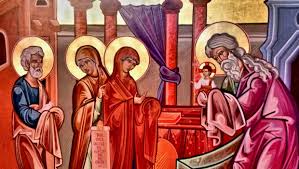 And she already knew well what that sword would be.
And she already knew well what that sword would be.
For the rest of the next thirty three years, she would live with this horrible knowledge. It would hang over her and pierce her heart day and night. It must have been wonderful to see her Boy as He “grew in wisdom and stature, and in favor with God and man.” Luke 2:52 – as somehow, in a way we cannot know, He grew also into the Human knowledge of what He must do. And all the while, she already 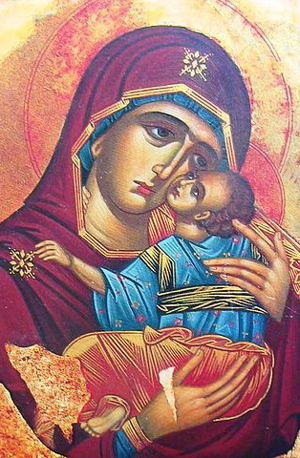 knew, and it must have about killed her. “The Mother of sorrows”, as Roman Catholics describe her.
knew, and it must have about killed her. “The Mother of sorrows”, as Roman Catholics describe her.
And that is why in our icons as she holds Him, she often looks so very sad.
So here again, as we enjoy the wonder and joy and good fun of Christmas, we too must always remember: This little newborn Child has come to die for us. Only 33 years later this Baby, then at the height of his Manhood, will voluntarily hang on a Cross, will die for all of us, and will lead us through the dark portal of death. And then He will conquer death, trampling down death by death, and lead us up with him out the darkness into the Light, into the Glory.
And that is why we say: Christ is born. Glorify him!
I promised that this Post would be a short one. But it isn’t. How do these things happen?
Next Week: Three? Magicians? Astrologers? Kings?
Week after Next: the series on The Divine Liturgy continues with The Pro-Anaphora

We don’t really know what things that St. Joseph and the Theotokos had to deal with while traveling. One should remember that everywhere they went was part of the Roman Empire, it was more like going from New York to Colorado than going from the US to Mexico. The Romans excelled at bureaucracy, so they probably did have to have papers of some sort to travel. Rome didn’t need walls, they had the Legions and they ruled the known world.
And December 25th was not chosen casually or arbitrarily. It was NOT chosen just because there was a pagan celebration. Several Christian writers calculated the date of the Lord’s Nativity long before the Roman celebration of Dies Natalis Solis Invicti—Birthday of the Unconquered Sun—was established. Ancient Christian writers built the timing for the birth of Christ from the Scriptural observation that Zechariah was on duty on Yom Kippur (September 23). This observation comes from the information we find in the gospel of Luke. “Once when Zechariah’s division was on duty and he was serving as priest before God, he was chosen by lot, according to the custom of the priesthood, to go into the temple of the Lord and burn incense. And when the time for the burning of incense came, all the assembled worshipers were praying outside. Then an angel of the Lord appeared to him, standing at the right side of the altar of incense” (Luke 1:8–11). The day of Yom Kippur is the day in which incense was offered in this manner. Based on this observation, Christians were able to calculate the birth of John the Forerunner as being September 23 + 270 days = June 24. They then observed that the Annunciation of Christ’s birth was six months after John the Baptist’s conception. “In the sixth month [of Elizabeth’s pregnancy] the angel Gabriel was sent from God to a city of Galilee named Nazareth, to a virgin betrothed to a man whose name was Joseph, of the house of David. And the virgin’s name was Mary” (Luke 1:26–27). Calculating September 23 and adding six months brings us to March 25. Through this reasoning, Irenaeus had established March 25 as the date of the Annunciation before the end of the second century. The Annunciation was being celebrated long before Christmas, since the Annunciation was miraculous, whereas the birth was a mere function of human biology. The date of December 25 is therefore derived from the date of Jesus’ conception. By the year 221 AD, three Christian writers had independently calculated the date of Jesus’ birth as December 25. Irenaeus, as we have just said, identified the date of his annunciation before the end of the second century. Hippolytus used a different method, but determined December 25 as the date of the Nativity in 202 AD when he wrote his commentary on Daniel 4:23. Finally, Sextus Julius Africanus, in writing his “Chronology of the World” in 221 AD had also calculated December 25.
Regarding the first paragraph: I wonder how quickly after Christ’s birth the Holy Family had to flee. Matthew says they fled “by night”, which would suggest they had to get out quickly, by stealth, unprepared. And I was wondering what it would be like for them if they lived today. Which He does: “Inasmuch as you have done it to the least of these my brethren you have done it to me.”
Regarding the second paragraph: I did not know any of this, but was just repeating what I had read and was taught. So thank you very much. I’m grateful to you for taking the time to write in with corrections. If you catch me again, please correct me again.
Addendum written about an hour later.
But this leaves me curious as to why Eastern Christians for a long time celebrated the Nativity not on Dec 25 but rather combined it with Epiphany on Jan 6.
“Addendum written about an hour later.
But this leaves me curious as to why Eastern Christians for a long time celebrated the Nativity not on Dec 25 but rather combined it with Epiphany on Jan 6.’
Forgive me for interjecting, I’d just like to suggest that this was likely due to the celebration of Feasts of the Lord individually on the day of their commemoration being relatively new. The separation of the Paschal feasts into Holy Week and Theophany into the Nativity and the Baptism [for which we retain the name Theophany] was a gradual process of what might be called the historicising of Liturgical Feasts which began in 4th century Jerusalem. Earlier all the events relating to His revelation of Himself to us -at His Birth to the shepherds , later to the Magi bearing gifts, and finally at His Baptism the revelation of the Trinity- were celebrated as one feast of the revelation of God i.e. θεοφάνεια. [Likewise, following the Jewish Liturgical model all the events relating to Christ’s Passion and Resurrection originally had one feast that of Pascha (Passover) – held on the 14 Nissan or the nearest Sunday depending on the local calendar]
Why should I “forgive” you for interjecting? Rather, let me thank you for sharing your knowledge.
The celebration on the 25 December is the same.
The calendar used originally was not coinciding with the seasons and months of the year so a new calendar was calculated. I think a day was added for Leap Year. Old Calendarists will be celebrating in what New Calendarists January.
The Christmas tree developed from a tree decorated with apples used in a German Church custom. to illustr ate the Adam and Eve story. I remember artificial apples in the 1960 s Scandinavian decorations The tree is pine or fir not an apple tree.When it became domestic I don,t know.
Thank you for your contribution. Interesting. I suspect there were many variations on even more ancient practices.
Regarding point 5 on the Some Implications of Christmas, there’s an interesting article at The Federalist on Jesus and immigration policy: https://thefederalist.com/2019/12/30/no-pete-buttigieg-jesus-wasnt-a-refugee-and-he-doesnt-endorse-your-immigration-policies/
Key quote: “To profane a holy day, politicize it.”
Food for thought.
I wasn’t trying to be political, honest! But only to describe the plight of the Holy Family. If I chose the wrong word to describe them, forgive me. According to the Cambridge Dictionary and Merriam-Webster, I don’t think I did, but that’s not the point. My point was that the Holy Family were fleeing for their lives from their homeland Palestine, because of persecution.
Likewise, it doesn’t make any difference who separates children (even infants, God help us all!) from their parents or keeps children alone in confinement. To do so is immoral.
“Likewise, it doesn’t make any difference who separates children (even infants, God help us all!) from their parents or keeps children alone in confinement. To do so is immoral.” Always and no matter what? What if the parents are criminals. Do you send their children to the jail as well? That might be how they do it in places like Turkey but it’s not how the justice system works in the USA. Children generally go into foster care at that point but with the volumes of people directly and patently encouraged by the Democrats to cross our borders, and many of them with children “on loan” as it were that are not really their own, some degree of separation becomes sadly necessary and, at least to my mind, not that immoral at all. Especially in the face of the horrendous amount of human trafficking and use of children not their own.
Help! I’m sorry that Post about our Lord’s Nativity has turned into a debate about social/political issues. As I wrote I was thinking only of the plight of the Holy Family in light today’s situation, and it seemed to me there were obvious parallels. Was I wrong?
You’re right: I should have said that it is immoral to separate children from their parents “under normal circumstances”, and that the situation is different if parents are criminals or a danger to their children or unable to care for them. I believe it is wrong to to do so for political reasons.
I have wanted this Blog to deal occasionally with social and moral issues from an Orthodox viewpoint. I think we Orthodox don’t do enough of that. My understanding of these is not dogma! and I’m glad to receive critiques and criticisms of them. However, I have never got into a direct political discussion of Democrats vs. Republicans vs. Socialists or whoever – nor would the management of Ancient Faith allow it. These have come up in a number of previous Comments, and I hope all will try to avoid that in the future, because that can interfere with the publishing of valid points people are making.